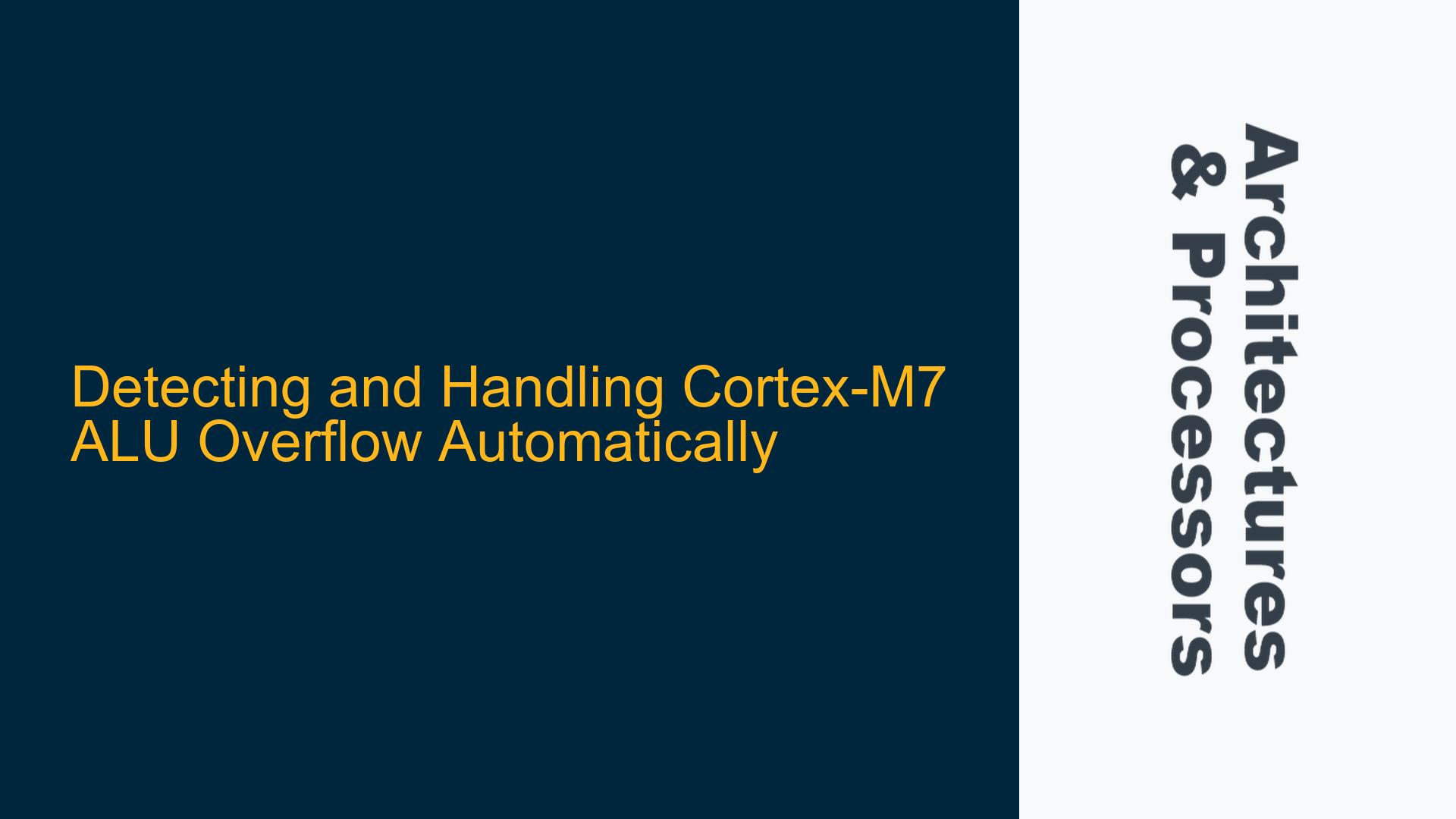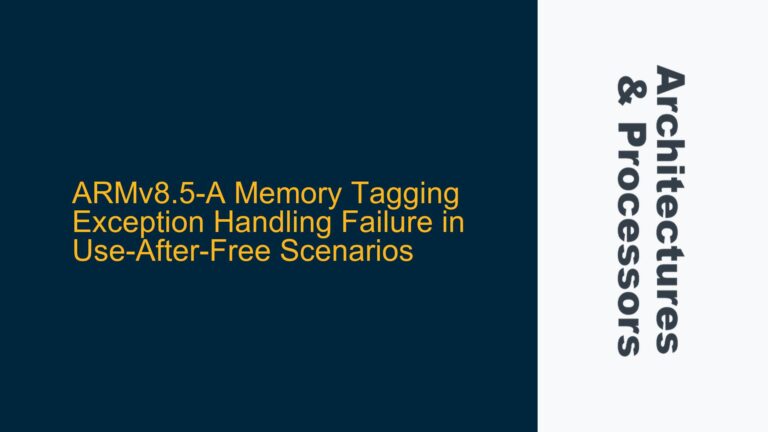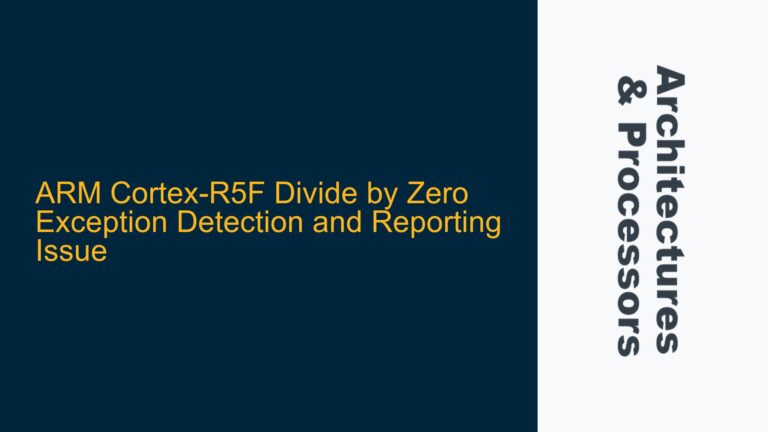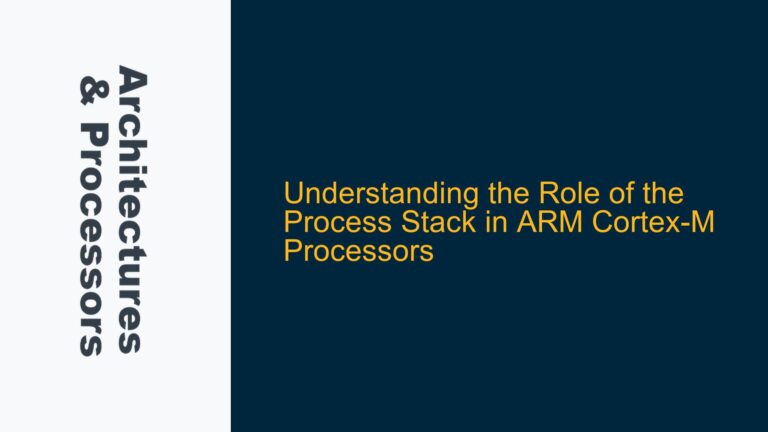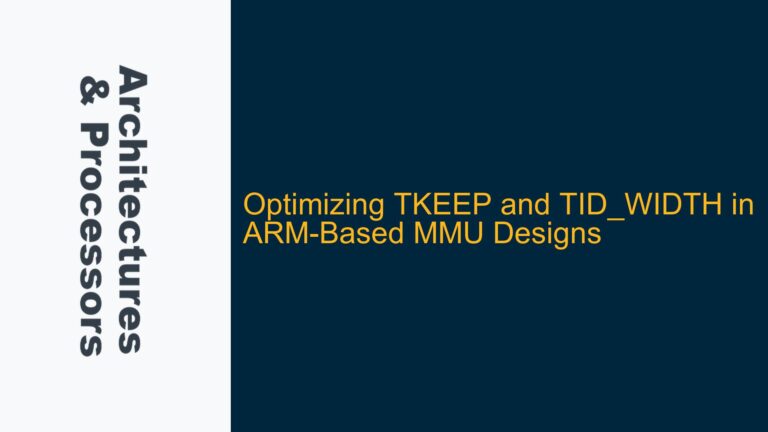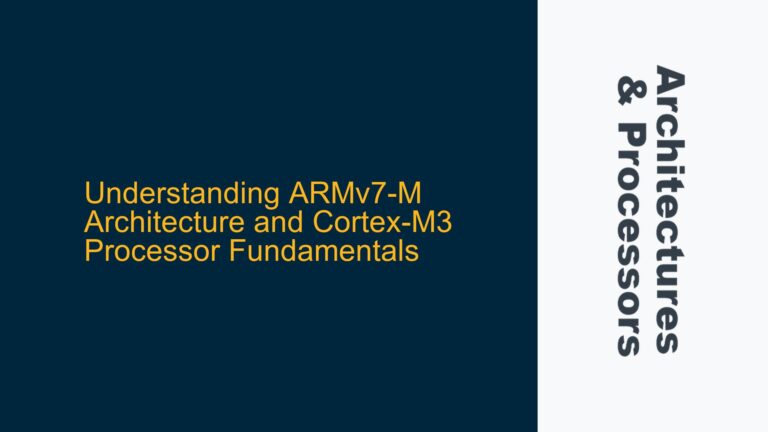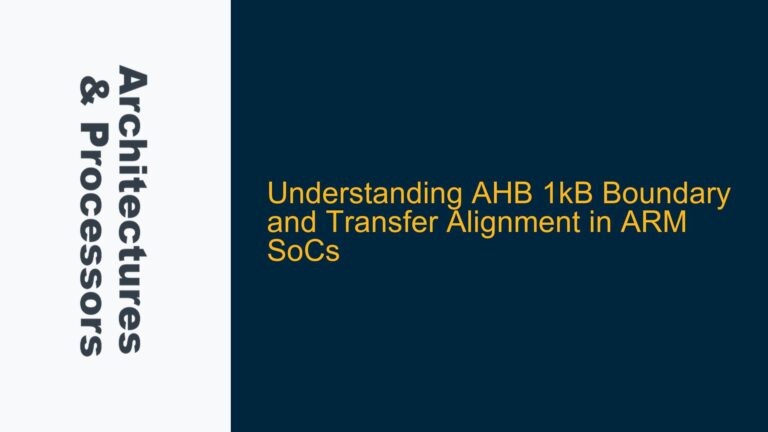Cortex-M7 ALU Overflow Detection Challenges
The ARM Cortex-M7 processor, known for its high performance and efficiency, is widely used in embedded systems requiring real-time processing capabilities. One of the critical aspects of ensuring reliable operation in such systems is the detection and handling of arithmetic logic unit (ALU) overflow. Overflow occurs when the result of an arithmetic operation exceeds the maximum or minimum value that can be represented by the destination register, leading to incorrect results and potential system failures.
In the Cortex-M7, the ALU performs arithmetic operations such as addition, subtraction, and multiplication. The processor’s Application Program Status Register (APSR) includes a V (overflow) flag that is set to 1 when an overflow occurs during an arithmetic operation. However, the V flag is cleared to 0 after the next operation, making it challenging to detect overflow automatically without explicit checks after each operation.
The primary challenge lies in the fact that the Cortex-M7 does not provide a built-in exception mechanism for ALU overflow detection, unlike the divide-by-zero exception, which is automatically triggered when a division by zero occurs. This lack of automatic detection means that developers must implement custom solutions to detect and handle ALU overflow, which can be both time-consuming and error-prone.
V Flag Behavior and Lack of Automatic Overflow Exception
The V flag in the APSR is a critical component for detecting overflow in the Cortex-M7 ALU. When an arithmetic operation results in an overflow, the V flag is set to 1, indicating that the result cannot be correctly represented in the destination register. However, the V flag is automatically cleared to 0 after the next arithmetic operation, regardless of whether that operation results in an overflow or not. This behavior makes it difficult to detect overflow without explicitly checking the V flag after each arithmetic operation.
The Cortex-M7 does not provide an automatic exception mechanism for ALU overflow detection. In contrast, the processor does generate an exception for divide-by-zero errors, which simplifies the handling of such errors. The absence of a similar mechanism for ALU overflow means that developers must manually check the V flag after each arithmetic operation to detect overflow, which can be cumbersome and inefficient, especially in performance-critical applications.
The lack of an automatic overflow detection mechanism also increases the risk of undetected overflow errors, which can lead to incorrect results and system failures. This is particularly problematic in safety-critical applications, where undetected errors can have severe consequences. Therefore, it is essential to implement robust mechanisms for detecting and handling ALU overflow in Cortex-M7-based systems.
Implementing Custom Overflow Detection and Handling
To address the challenges of detecting and handling ALU overflow in the Cortex-M7, developers can implement custom solutions that involve explicit checks of the V flag after each arithmetic operation. This approach requires careful consideration of the specific requirements of the application, as well as the performance implications of adding additional checks.
One common approach is to use inline assembly or compiler intrinsics to check the V flag after each arithmetic operation. This allows developers to insert the necessary checks directly into the code, ensuring that overflow is detected immediately after it occurs. However, this approach can be cumbersome and error-prone, especially in large codebases with many arithmetic operations.
Another approach is to use a combination of hardware and software techniques to detect and handle overflow. For example, developers can use the Cortex-M7’s Data Watchpoint and Trace (DWT) unit to monitor specific memory locations for changes that indicate an overflow. This approach can be more efficient than manually checking the V flag after each operation, but it requires careful configuration and may not be suitable for all applications.
In addition to detecting overflow, developers must also implement mechanisms for handling overflow errors. This can include logging the error, triggering an exception, or taking corrective action to prevent system failure. The specific handling mechanism will depend on the requirements of the application and the severity of the overflow error.
To summarize, detecting and handling ALU overflow in the Cortex-M7 requires a combination of careful coding practices, hardware monitoring, and robust error handling mechanisms. By implementing these techniques, developers can ensure that their systems are able to detect and handle overflow errors effectively, reducing the risk of incorrect results and system failures.
Detailed Explanation of V Flag Behavior
The V flag in the APSR is a single-bit flag that indicates whether an arithmetic operation has resulted in an overflow. The V flag is set to 1 if the result of an operation cannot be correctly represented in the destination register, and it is cleared to 0 after the next arithmetic operation. This behavior is consistent across all arithmetic operations, including addition, subtraction, and multiplication.
The V flag is set based on the result of the arithmetic operation and the size of the destination register. For example, in a 32-bit addition operation, the V flag will be set if the result exceeds the maximum value that can be represented by a 32-bit signed integer (2,147,483,647) or if the result is less than the minimum value that can be represented by a 32-bit signed integer (-2,147,483,648). Similarly, in a 32-bit subtraction operation, the V flag will be set if the result exceeds the maximum or minimum value that can be represented by a 32-bit signed integer.
The V flag is cleared to 0 after the next arithmetic operation, regardless of whether that operation results in an overflow or not. This means that the V flag only indicates the result of the most recent arithmetic operation, and it does not retain information about previous operations. As a result, developers must check the V flag immediately after each arithmetic operation to detect overflow.
Challenges in Detecting Overflow Automatically
The primary challenge in detecting ALU overflow automatically in the Cortex-M7 is the lack of a built-in exception mechanism for overflow detection. Unlike divide-by-zero errors, which trigger an automatic exception, ALU overflow does not generate an exception. This means that developers must implement custom solutions to detect and handle overflow, which can be both time-consuming and error-prone.
Another challenge is the behavior of the V flag, which is cleared after each arithmetic operation. This means that developers must check the V flag immediately after each operation to detect overflow, which can be cumbersome and inefficient, especially in performance-critical applications. Additionally, the V flag only indicates the result of the most recent operation, so developers must ensure that they check the V flag after every arithmetic operation to avoid missing overflow errors.
The lack of an automatic overflow detection mechanism also increases the risk of undetected overflow errors, which can lead to incorrect results and system failures. This is particularly problematic in safety-critical applications, where undetected errors can have severe consequences. Therefore, it is essential to implement robust mechanisms for detecting and handling ALU overflow in Cortex-M7-based systems.
Custom Solutions for Overflow Detection
To address the challenges of detecting and handling ALU overflow in the Cortex-M7, developers can implement custom solutions that involve explicit checks of the V flag after each arithmetic operation. This approach requires careful consideration of the specific requirements of the application, as well as the performance implications of adding additional checks.
One common approach is to use inline assembly or compiler intrinsics to check the V flag after each arithmetic operation. This allows developers to insert the necessary checks directly into the code, ensuring that overflow is detected immediately after it occurs. However, this approach can be cumbersome and error-prone, especially in large codebases with many arithmetic operations.
Another approach is to use a combination of hardware and software techniques to detect and handle overflow. For example, developers can use the Cortex-M7’s Data Watchpoint and Trace (DWT) unit to monitor specific memory locations for changes that indicate an overflow. This approach can be more efficient than manually checking the V flag after each operation, but it requires careful configuration and may not be suitable for all applications.
In addition to detecting overflow, developers must also implement mechanisms for handling overflow errors. This can include logging the error, triggering an exception, or taking corrective action to prevent system failure. The specific handling mechanism will depend on the requirements of the application and the severity of the overflow error.
Implementing Data Watchpoint and Trace (DWT) for Overflow Detection
The Cortex-M7’s Data Watchpoint and Trace (DWT) unit can be used to monitor specific memory locations for changes that indicate an overflow. The DWT unit is a powerful tool for debugging and performance monitoring, and it can be configured to trigger an interrupt or exception when a specific memory location is accessed or modified.
To use the DWT unit for overflow detection, developers can configure it to monitor the memory location where the result of an arithmetic operation is stored. If the result exceeds the maximum or minimum value that can be represented by the destination register, the DWT unit can trigger an interrupt or exception, allowing the developer to handle the overflow error.
This approach can be more efficient than manually checking the V flag after each arithmetic operation, as it offloads the detection process to the hardware. However, it requires careful configuration and may not be suitable for all applications, especially those with tight performance constraints.
Handling Overflow Errors
Once an overflow error has been detected, developers must implement mechanisms for handling the error. The specific handling mechanism will depend on the requirements of the application and the severity of the overflow error.
One common approach is to log the error and continue execution. This approach is suitable for non-critical applications where the impact of an overflow error is minimal. The error log can be used for debugging and analysis, allowing developers to identify and fix the root cause of the overflow.
Another approach is to trigger an exception or interrupt when an overflow error is detected. This approach is suitable for critical applications where the impact of an overflow error is severe. The exception or interrupt handler can take corrective action, such as resetting the system or switching to a backup algorithm, to prevent system failure.
In some cases, developers may choose to implement a combination of logging and exception handling. For example, the system could log the error and continue execution if the overflow is not critical, but trigger an exception if the overflow is severe.
Performance Considerations
Implementing custom solutions for detecting and handling ALU overflow in the Cortex-M7 can have performance implications, especially in performance-critical applications. Adding explicit checks of the V flag after each arithmetic operation can increase the execution time and code size, which may not be acceptable in some applications.
To minimize the performance impact, developers can use techniques such as conditional compilation and inline assembly to optimize the overflow detection code. Conditional compilation allows developers to include or exclude the overflow detection code based on the specific requirements of the application, while inline assembly allows developers to write highly optimized code for checking the V flag.
In addition, developers can use the Cortex-M7’s DWT unit to offload the overflow detection process to the hardware, reducing the performance impact on the software. However, this approach requires careful configuration and may not be suitable for all applications.
Conclusion
Detecting and handling ALU overflow in the Cortex-M7 is a critical aspect of ensuring reliable operation in embedded systems. The lack of an automatic overflow detection mechanism means that developers must implement custom solutions to detect and handle overflow, which can be both time-consuming and error-prone.
By understanding the behavior of the V flag and implementing custom solutions such as inline assembly, compiler intrinsics, and hardware monitoring, developers can effectively detect and handle ALU overflow in Cortex-M7-based systems. Additionally, by considering the performance implications and implementing robust error handling mechanisms, developers can ensure that their systems are able to detect and handle overflow errors effectively, reducing the risk of incorrect results and system failures.
In summary, detecting and handling ALU overflow in the Cortex-M7 requires a combination of careful coding practices, hardware monitoring, and robust error handling mechanisms. By implementing these techniques, developers can ensure that their systems are able to detect and handle overflow errors effectively, reducing the risk of incorrect results and system failures.
